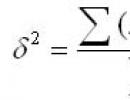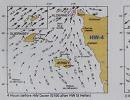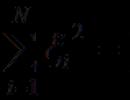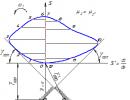The maximum number of points exam chemistry. What is the maximum number of points for the exam. Minimum score for admission to the budget
Since 2001, many schoolchildren have been familiar with the new kind exam - USE (unified state exam), despite the fact that its introduction into the system school education happened smoothly, they did not become less afraid of him. Future graduates are interested in questions about the number of upcoming exams, but also about the scores they should receive.
USE scores

There are three types of minimum scores that students can receive based on the results of the passed exam:
- The first type gives the right to receive a certificate;
- The second makes it possible to apply to higher educational institutions of the country;
- The third one is sufficient for admission to a budgetary basis in a specific specialty, in a certain university of the country.
It is not surprising that for many students, the exam has become a rather strong emotional test, in fact, you should not wind yourself up too much before passing the exams, you need to prepare well and be self-confident. Despite the severity of the conduct, this is just an exam that can be retaken in case of failure. With proper training and approach, passing the exam is not so difficult.
AT USE forms various tasks are presented, they must be completed in a certain time, as they pass, the student receives primary scores, each item has its own maximum values. During the test of the level of knowledge, the primary scores are converted into the resulting ones and it is they who are entered in the certificate, they are the main ones when entering a university.
Planned passing scores in 2018

There is still time before the exam, and many who wish can get acquainted with the passing scores in 2018, not only to know them, but also to be able to prepare for the exam in advance.
| Subject | Grade 5 | Grade 4 | Grade 3 | Did not pass |
| Russian language | 72 and more | 58 — 71 | 36 — 57 | 35 and under |
| Maths | 65 and more | 47 — 64 | 27 — 46 | 26 and under |
| Physics | 68 and more | 53 — 67 | 36 — 52 | 35 and under |
| Foreign language | 84 and more | 59 — 83 | 22 — 58 | 21 and under |
| Geography | 67 and more | 51 — 66 | 37 — 50 | 36 and under |
| Informatics | 73 and more | 57 — 72 | 40 — 56 | 39 and under |
| Social science | 67 and more | 55 — 66 | 42 — 54 | 41 and under |
| Story | 68 and more | 50 — 67 | 32 — 49 | 41 and under |
| Literature | 67 and more | 55 — 66 | 32 — 54 | 31 and under |
| Biology | 72 and more | 55 — 71 | 36 – 54 | 35 and under |
| Chemistry | 73 and more | 56 — 72 | 36 — 55 | 35 and under |
Many universities announce in advance the score required for admission to a budget place, this allows you to realistically assess your chances of getting into the chosen one. educational institution and choose the most suitable options. In 2018, no major changes are expected when passing the Unified State Examination and entering a university, students can focus on the data of the previous year, so in 2017 for educational institutions of the capital the passing score was 80 - 90, for other cities the requirements are not so high and vary between 65 - 75 points.
Will there be changes in 2018
At first glance, there is simply nothing to change in the education system, nevertheless, the level of education in our country is getting lower and lower every year, it is reasonable to conclude that it is time to change everything. It is hard for everyone and the students, and their parents, and of course, the teachers. The requirements are getting higher and higher every year, for many the exam is stressful, some cannot cope with such pressure.
Today, mathematics and Russian are compulsory subjects for delivery, more are planned to be added in 2018. Since 2009, compulsory exams have been held in subjects that are not only graduation at school, but also entrance to the universities of our country, it is not surprising that there are plans to introduce history as another compulsory subject. It is planned to implement the plan in 2018 or 2019, in any case, the data will either be confirmed or refuted very soon.
Attitude towards the exam
Since 2001, the attitude towards the USE is still relevant, some oppose it, others defend it as a progress in the education system, there are those who do not focus on it, continuing to study and teach.
"Against" the exam
Similar content

After checking the USE assignments in mathematics, a primary score is set for their implementation:
- For the basic level in mathematics - from 0 to 20;
- For the profile level in mathematics - from 0 to 30.
Each task is evaluated by a certain number of points: the more difficult the task, the more points you can get for it. For the correct performance of each task in the exam in mathematics at the basic level, 1 point is given. For the correct completion of tasks in the USE in mathematics at the profile level, from 1 to 4 points are given, depending on the complexity of the task.
After that, the primary score is converted into a test score, which is indicated in the USE certificate. It is this score that is used for admission to higher educational institutions. Translation of USE scores carried out using a special scoring scale. The USE score in basic mathematics is not required for admission, so it is not converted into a test score and is not indicated in the USE certificate.
Also, by the score for the exam, you can determine the approximate grade on a five-point scale that a student would receive for completing tasks on the exam.
Below is USE score conversion scale in mathematics for basic and profile levels: Primary scores, test scores and a rough estimate.
USE score conversion scale: mathematics basic level
USE score conversion scale: mathematics profile level
The minimum test score for admission to higher education is 27.
| Primary score | Test score | Grade |
|---|---|---|
| 0 | 0 | 2 |
| 1 | 5 | |
| 2 | 9 | |
| 3 | 14 | |
| 4 | 18 | |
| 5 | 23 | |
| 6 | 27 | 3 |
| 7 | 33 | |
| 8 | 39 | |
| 9 | 45 | |
| 10 | 50 | 4 |
| 11 | 56 | |
| 12 | 62 | |
| 13 | 68 | 5 |
| 14 | 70 | |
| 15 | 72 | |
| 16 | 74 | |
| 17 | 76 | |
| 18 | 78 | |
| 19 | 80 | |
| 20 | 82 | |
| 21 | 84 | |
| 22 | 86 | |
| 23 | 88 | |
| 24 | 90 | |
| 25 | 92 | |
| 26 | 94 | |
| 27 | 96 | |
| 28 | 98 | |
| 29 | 99 | |
| 30 | 100 |
| the date | USE |
|---|---|
| early period | |
| March 20 (Fri) | geography, literature |
| March 23 (Mon) | Russian language |
| March 27 (Fri) | math B, P |
| March 30 (Wed) | foreign languages(except for the "Speaking" section), biology, physics |
| April 1 (Wed) | |
| April 3 (Fri) | social science, informatics and ICT |
| April 6 (Mon) | history, chemistry |
| April 8 (Wed) | reserve: geography, chemistry, informatics and ICT, foreign languages (Speaking section), history |
| April 10 (Fri) | reserve: foreign languages (except for the "Speaking" section), literature, physics, social science, biology |
| April 13 (Mon) | reserve: Russian language, mathematics B, P |
| main stage | |
| May 25 (Mon) | geography, literature, informatics and ICT |
| May 28 (Thu) | Russian language |
| June 1 (Mon) | math B, P |
| June 4 (Thurs) | history, physics |
| June 8 (Mon) | social science, chemistry |
| June 11 (Thu) | foreign languages (except for the "Speaking" section), biology |
| June 15 (Mon) | foreign languages (section "Speaking") |
| June 16 (Tue) | foreign languages (section "Speaking") |
| June 18 (Tue) | reserve: history, physics |
| June 19 (Fri) | reserve: geography, literature, informatics and ICT, foreign languages (section "Speaking") |
| June 20 (Sat) | reserve: foreign language (except for the "Speaking" section), biology |
| June 22 (Mon) | reserve: Russian |
| June 23 (Tue) | reserve: social science, chemistry |
| June 24 (Wed) | reserve: history, physics |
| June 25 (Thu) | reserve: mathematics B, P |
| June 29 (Mon) | reserve: in all subjects |
The number of participants in the USE in physics in 2018 (main day) was 150,650 people, including 99.1% of graduates of the current year. The number of participants in the exam is comparable to the previous year (155,281 people), but lower than the number in 2016 (167,472 people). In percentage terms, the number of participants in the USE in physics amounted to 23% of the total number of graduates, which is slightly lower than last year. A slight decrease in the number of students taking the USE in physics may be due to an increase in universities that accept entrance test informatics.
The largest number of participants in the USE in physics is noted in Moscow (10,668), the Moscow Region (6,546), St. Petersburg (5,652), the Republic of Bashkortostan (5,271) and Krasnodar Territory (5060).
The average USE score in physics in 2018 was 53.22, which is comparable to last year's score (53.16 test scores). The maximum test score was scored by 269 exam participants from 44 constituent entities of the Russian Federation, in the previous year there were 278 people with 100 points. Minimum score The USE in physics in 2018, as in 2017, was 36 tb, but in primary scores it was 11 points, compared to 9 primary points in the previous year. The proportion of exam participants who did not pass the minimum score in 2018 was 5.9%, which is slightly higher than those who did not reach the minimum score in 2017 (3.79%).
Compared to the previous two years, the proportion of poorly trained participants slightly increased (21-40 tb). The share of high-scorers (61-100 TB) increased, reaching the maximum values for three years. This allows us to talk about the strengthening of differentiation in the training of graduates and the growth in the quality of training of students studying the profile course of physics.
In 2018, the proportion of exam participants who scored 81-100 points was 5.61%, which is higher than in 2017 (4.94%). For the USE in physics, the range from 61 to 100 test scores is significant, which demonstrates the readiness of graduates to successfully continue their education in universities. This year, this group of graduates increased compared to the previous year and amounted to 24.22%.
More detailed analytics and teaching materials The USE 2018 is available at the link.
Our website contains about 3000 tasks for preparing for the exam in physics in 2019. Overall plan examination paper is presented below.
PLAN OF THE EXAMINATION WORK OF THE USE IN PHYSICS 2019
Designation of the level of difficulty of the task: B - basic, P - advanced, C - high.
Content elements and activities to be checked |
Task difficulty level |
Maximum score for completing the task |
| Exercise 1. Uniform rectilinear motion, uniformly accelerated rectilinear motion, circular motion | ||
| Task 2. Newton's laws, law of universal gravitation, Hooke's law, friction force | ||
| Task 3. Law of conservation of momentum, kinetic and potential energies, work and power of force, law of conservation of mechanical energy | ||
| Task 4. Equilibrium condition solid body, Pascal's law, Archimedes force, mathematical and spring pendulums, mechanical waves, sound | ||
| Task 5. Mechanics (explanation of phenomena; interpretation of the results of experiments presented in the form of tables or graphs) | ||
| Task 6. Mechanics (change of physical quantities in processes) | ||
| Task 7. Mechanics (establishing a correspondence between graphs and physical quantities; between physical quantities and formulas) | ||
| Task 8. Relationship between pressure and average kinetic energy, absolute temperature, relationship between temperature and average kinetic energy, Mendeleev-Clapeyron equation, isoprocesses | ||
| Task 9. Work in thermodynamics, first law of thermodynamics, heat engine efficiency | ||
| Task 10. Relative air humidity, amount of heat | ||
| Task 11. MKT, thermodynamics (explanation of phenomena; interpretation of the results of experiments presented in the form of tables or graphs) | ||
| Task 12. MKT, thermodynamics (change of physical quantities in processes; establishment of correspondence between graphs and physical quantities, between physical quantities and formulas) | ||
| Task 13. The principle of superposition of electric fields, the magnetic field of a current-carrying conductor, the Ampère force, the Lorentz force, Lenz's rule (direction determination) | ||
| Task 14. Law of conservation of electric charge, Coulomb's law, capacitor, current strength, Ohm's law for a circuit section, series and parallel connection of conductors, work and current power, Joule-Lenz law | ||
| Task 15. Magnetic induction vector flux, law electromagnetic induction Faraday, inductance, energy magnetic field coils with current, oscillatory circuit, laws of reflection and refraction of light, path of rays in a lens | ||
| Task 16. Electrodynamics (explanation of phenomena; interpretation of the results of experiments presented in the form of tables or graphs) | ||
| Task 17. Electrodynamics (change of physical quantities in processes) | ||
| Task 18. Electrodynamics and the basics of SRT (establishing a correspondence between graphs and physical quantities, between physical quantities and formulas) | ||
| Task 19. Planetary model of the atom. Nucleon model of the nucleus. Nuclear reactions. | ||
| Task 20. Photons, line spectra, radioactive decay law | ||
| Task 21. Quantum physics (changing physical quantities in processes; establishing correspondence between graphs and physical quantities, between physical quantities and formulas) | ||
| Task 22. | ||
| Task 23. Mechanics - the quantum physics(methods of scientific knowledge) | ||
| Task 24. Elements of astrophysics: solar system, stars, galaxies | ||
| Task 25. Mechanics, molecular physics (calculation problem) | ||
| Task 26. Molecular physics, electrodynamics (calculation problem) | ||
| Task 27. | ||
| Task 28 (C1). Mechanics - quantum physics (qualitative task) | ||
| Task 29 (C2). Mechanics (calculation problem) | ||
| Task 30 (С3). Molecular physics (calculation problem) | ||
| Task 31 (С4). Electrodynamics (calculation problem) | ||
| Task 32 (C5). Electrodynamics, quantum physics (calculation problem) |
Correspondence between the minimum primary scores and the minimum test scores of 2019. Order on amendments to Appendix No. 1 to the order of the Federal Service for Supervision in Education and Science.
THRESHOLD SCORE
The order of Rosobrnadzor established the minimum number of points, confirming the development by the participants of the exams of the main general educational programs of the secondary (full) general education in accordance with the requirements of the federal state educational standard secondary (complete) general education. PHYSICS THRESHOLD: 11 primary points(36 test points).
EXAM FORMS
You can download the forms in high quality from the link.
WHAT YOU CAN BRING WITH YOU TO THE EXAM
At the physics exam, the use of a ruler for plotting graphs, optical and electrical circuits is allowed; a non-programmable calculator that performs arithmetic calculations (addition, subtraction, multiplication, division, root extraction) and calculation trigonometric functions(sin, cos, tg, ctg, arcsin, arcos, arctg), as well as not performing the functions of a means of communication, database storage and not having access to data transmission networks (including the Internet). .
Each graduate who wants to become a student of one of the universities of the Russian Federation in 2018 faces a difficult task - to successfully pass the exam, as well as to choose the right educational institution and faculty for submitting documents. The majority of 11th graders and their parents are faced with the final exam grading system for the first time and often find it difficult to find answers to the questions that arise. Therefore, we decided to shed light on important points.
In 2017-2018 the main rules passing the exam will not change significantly. This means that the 100-point system for grading final tests will still be relevant for graduates.
How is everything going?
During the examination of examination papers, for each correctly completed task, the graduate receives the so-called “primary scores”, which, upon completion of the examination of the work, are summed up and converted into a “test score”, which is indicated in the USE certificate.
Important! Since 2009, the scale for converting primary and test USE scores into traditional five-point grades for schools has not been officially used, because in 2017 and 2018 final exams are not included in the certificate.
Checking work is done in two ways:
- automatically (with the help of special programs and technical means);
- manually (the correctness of detailed answers is checked by two independent experts).
It is quite difficult to challenge the result of an automatic check. If the basic rules were not followed when filling out the answer table, the computer may not protect the result, and only the graduate himself, who did not follow a number of mandatory rules, will be to blame for this.

If controversial issues arise during the expert review, a third specialist is involved, whose opinion will be decisive.
When to expect results?
The following time limits apply by law:
- data processing (for compulsory subjects) at the RCSC should not last longer than 6 calendar days;
- for data processing (subjects of choice) RTsOI give 4 days;
- verification at the Federal Testing Center should take no more than 5 working days;
- approval of the results by the State Examination Commission - 1 more day;
- up to 3 days to send the results to the USE participants.
In practice, from the moment you pass the exam to getting your hands on official result may take 8 to 14 days.
Converting USE scores to grade
Despite the fact that officially in 2018 the scale for transferring points according to USE subjects in a five-point assessment is not used, many still want to interpret their result in a more familiar "school" system. To do this, you can use special tables or online calculators.
Table for converting OGE test scores into grades
Russian language | ||||
Maths | ||||
Informatics | ||||
Social science | ||||
Foreign languages | ||||
Biology | ||||
Geography | ||||
Literature | ||||
The second method is a little easier and more convenient than searching for the desired values in the cells of a huge table. It is enough just to choose a subject (mathematics, Russian, chemistry, physics, history, English language, social studies ... and other subjects), enter data and get the desired result in a matter of seconds.
We suggest trying how simple and convenient it is to use in practice the online calculators of the USE score and its conversion to a 5-point grade.
Transfer of points from primary to test
Converting USE scores to grades
Internet systems for applicants
The academic year 2017-2018 is over, the exam has been passed, the results are known, and even the interactive scale for transferring primary scores showed that USE result located in a fairly good range ... But, is this enough to enter the desired university?
Assess the real chances of entry, based on test scores and the minimum passing threshold set by the university.
Important! The minimum passing score is formed by the university itself. It will directly depend on the scores of applicants who apply in 2018. The more popular the specialty, the higher the passing score will be.
Often, at the TOP faculties, even 100-point results are not enough for admission to the budget. Only winners of the Olympiads, who give significant additional points, have a chance to see their last name in the lists of applicants for such areas.

In 2018, the most popular services for selecting a university and monitoring the entrance score threshold for various specialties will be:
- Ucheba.ru
- Apply online
- HSE calculator
- Postyplenie.ru
- Typical entrant
Finding these services is very easy. It is enough to enter their name into any search engine.
Each graduate is well aware that in order to successfully enter the specialty of interest, it is necessary to prepare well for the Unified State Examination 2018 and score the highest possible points. What does it mean to “pass the exam well” and how many points will be enough to compete for a budget place in a particular university? This will be discussed in this article.
We will cover the following important questions:
First of all, it is important to understand what exists:
- the minimum score that gives the right to receive a certificate;
- the minimum score that allows you to apply to the university;
- the minimum score sufficient for real income to the budget in a particular specialty at a particular university in Russia.
Naturally, these figures differ significantly.
Minimum certification score
The minimum attestation scores of the Unified State Examination are set for compulsory subjects - the Russian language and mathematics at the basic level, and in 2018 are:
Having overcome this threshold, but not reaching the minimum test score, the examinee will receive a certificate, but will not be able to apply to the university.
Minimum test score
The test minimum is the threshold value that gives the right to enter the university. In other words, persons who have overcome the test threshold theoretically have the right to join the fight for budget places. Although, in practice, it is almost impossible to enter highly rated universities with minimal performance.
In 2018, in all subjects except the Russian language and basic mathematics test minimum scores of the USE coincide with the attestation ones and are:
Subject | Minimum test score |
Russian language | |
Mathematics (basic level) | |
Mathematics (profile level) | |
Social science | |
Literature | |
Foreign language | |
Biology | |
Informatics | |
Geography |
The principle of calculating the success of passing a single state exam assumes that the subject must demonstrate a high, average or sufficient level of knowledge, corresponding to the grades "5", "4" and "3" in the school scale.
In case of an unsatisfactory result, as well as when passing a score that the examinee considers insufficient for himself, graduates are given the right to retake the exam.
Minimum score for admission to the budget
Most universities provide threshold score necessary for applicants for a budget place. This allows each applicant to realistically assess the prospects for admission and choose universities and specialties based on the points scored in the USE.
In 2018, you can focus on the fact that last season the average passing scores in all subjects of the Unified State Examination among applicants who entered MGIMO and other highly rated universities in the capital fluctuated between the threshold value of 80-90. But, for most regional universities of the Russian Federation, 65-75 points can already be considered a competitive result.

Converting the primary score to the resulting one
By completing the tasks proposed in the USE ticket, the examinee gains the so-called primary points, maximum value which varies depending on the subject. When evaluating the level of knowledge, such primary scores are converted into the resulting ones, which are entered in the certificate and are basic upon admission.
By using online calculator, you can compare primary and test scores in subjects of interest.
Just like last year, in 2018, recruited during the passage USE scores affect the score of the certificate and, although the table for comparing the test score and traditional grades is not officially accepted, you can approximately compare your scores right now using the universal calculator.
Passing scores of the top 10 universities in Russia
total |
||
| Moscow State University them. M.V. Lomonosov | ||
| Moscow Institute of Physics and Technology | ||
| National Research Nuclear University MEPhI | ||
| Saint Petersburg State University | ||
| Moscow state institute international relations | ||
| National research university « graduate School economy" | ||
| Moscow State Technical University named after N.E. Bauman | ||
| National Research Tomsk Polytechnic University | ||
| Novosibirsk National Research State University | ||
| St. Petersburg Polytechnic University of Peter the Great |
Please note that the average passing scores for different specialties in the same university can vary significantly. This figure reflects the minimum score of applicants who entered the budget, and tends to change every year. The results of 2017 can only serve as a guideline for applicants in 2018, motivating them to achieve the highest possible results.
There are many factors that affect the minimum passing score, including:
- the total number of graduates who have applied and the scores indicated on their certificates;
- the number of applicants who provided original documents;
- the number of beneficiaries.

So, seeing your last name in 20th place in the list of specialty, providing for 40 budget places, you can safely consider yourself a student. But, even if you find yourself on this list of 45, there is no reason to be upset if among those standing in front of you there are 5-10 people who provided copies of documents, because most likely these people are tuned to another university and applied for this specialty as a fallback .






